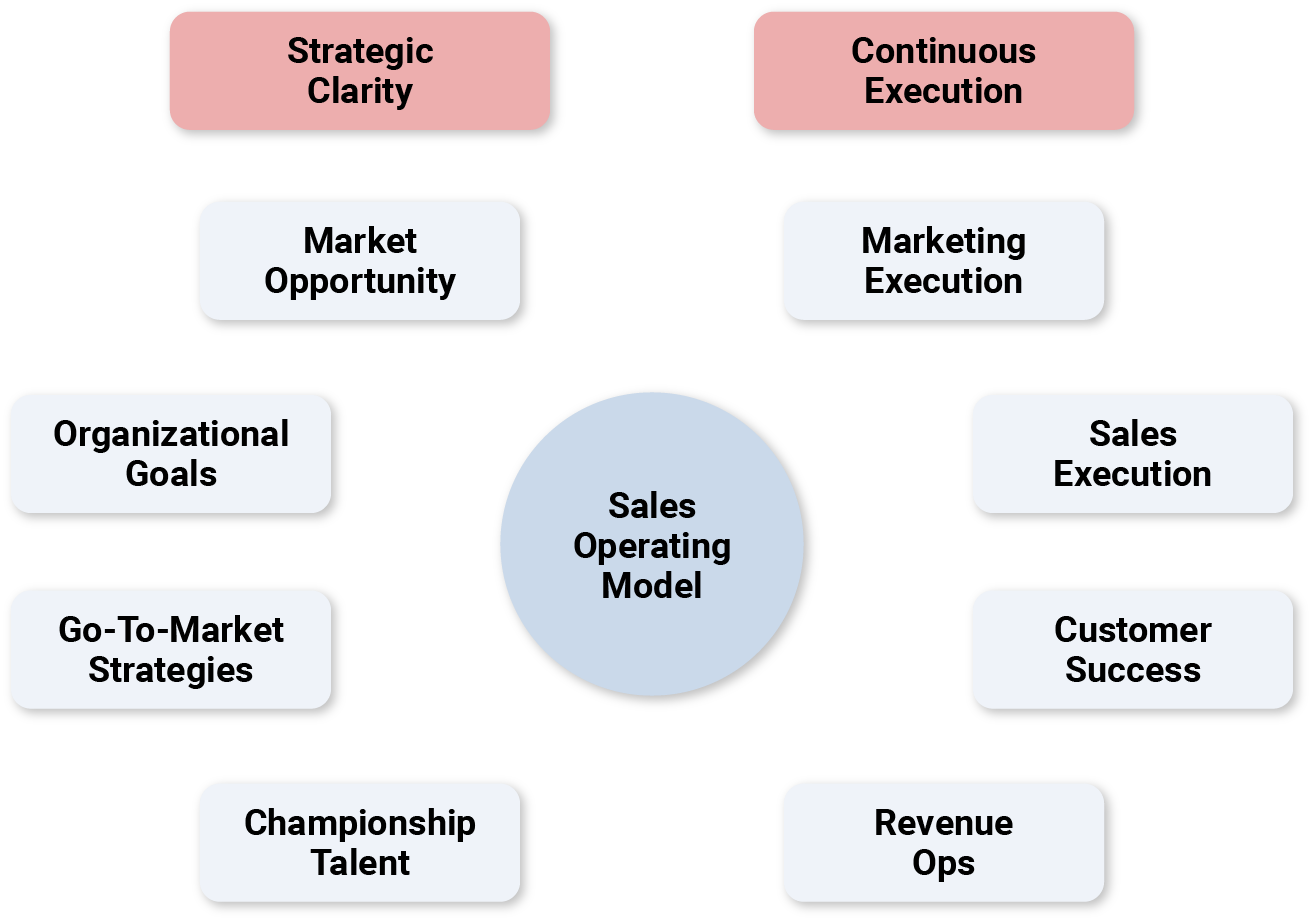High-Tech Companies Have Used The Usual Band-Aids To Fix Go-To-Market Failures.
Multiple Times.
It’s Time To Attack The Structural Weaknesses To Create Revenue Velocity.
High-performance companies build their success on operating models that produce superior, predictable and sustained results. Dig into organizations from banking to manufacturing to the University of Alabama football team and ‘the system’ quickly emerges as a vital separation factor.
But, for many B2B high-tech vendors, the most important ‘system’ – the Go-To-Market model – isn’t working. With astounding frequency, I see companies underestimate its scope and complexity, ignore critical deliverables, execute erratically and operate in disconnected silos. The usual outcome is results fall short of the Ops Plan, market influence is somewhere south of irrelevant, ineffective spending consumes capital and sporadic performance frustrates investors.
For many of these companies, the reason their GTM model isn’t working is because they really don’t have a model. Instead, a mishmash of loosely-connected activities masquerades as a GTM model. No way that approach will deliver those superior, predictable and sustained results – with a huge emphasis on “sustained”.
The GTM model is at the heart of operating, market, capital and team performance. Optimizing that performance is much more than simply funding pipeline development, deal management and customer success programs. It requires an operating model that produces a competitive advantage, measured by market share and revenue growth, team productivity, spend effectiveness, customer success and cycle time metrics.
After 30 years as a high-tech CRO, advisor and investor, I kept looking for a replicable GTM model that would produce those stellar and sustained results. As you have probably guessed, I never found it so I created the Sales Operating Model.
Create Competitive Advantage Though The Sales Operating Model (SOM)

The GTM model is at the core of operating, market, capital and team performance. That’s an enormous job and it has become much bigger in 2023 as we battle an economic downcycle for the first time in 14 years.
The only thing that matches the GTM model impact is its challenge. All-too-often companies underestimate its scope and complexity, ignore critical deliverables, execute erratically and operate in disconnected silos. I get it. The GTM model is hard to get right and costly to get wrong. That is precisely why I created the Sales Operating Model.
The SOM converts the broad scope and complexity into an integrated business process, designed with 3 pillars – Strategic Clarity, Continuous Execution and Championship Talent. Each pillar, on its own, plays a vital role in creating a high-performance organization. Each pillar, fully aligned across the model, transforms sales and marketing into a true competitive advantage.
The SOM is both broader and far more detailed – humble apologies for the summary description but I can’t give away all my secrets on a free web site. Contact me and we can discuss in much greater detail.
Create Competitive Advantage Through Strategic Clarity
- Category Design
- Market Prioritization
- Identity Design
- Solution Packaging
- Route-To-Market
Strategy by design, not default. The SOM’s foundation is an integrated set of 5 strategies that differentiate, direct and unify the organization.
The process begins with the often-overlooked category design initiative that analyzes market maturity, trends that drive the market and key initiatives that accelerate category growth. Market Prioritization is the process of identifying lucrative and winnable markets.
Identity Design is probably the toughest strategy to get right. It’s really hard to create an intuitive, differentiated, memorable and provocative identity. That process requires a potent combo of vision, creative genius and message architecture. The greater challenge is an internal launch that gets the entire team on the same page, telling the story with conviction, constancy and consistency. The end game is always a ‘One Company, One Message’ outcome – easy to say, brutally hard to achieve.
Solution Packaging is the process of defining how solutions are positioned, priced and sold across all selling environments. The Route-To-Market is the mix of channels needed to engage, win and deploy deals with the target market.
Strategic Clarity occurs when those 5 strategies are aligned with an organization’s capabilities and the entire team understands the direction, their role and, most importantly, passionately embraces the roadmap (the definition is a bit wordy but each component is critical).
Create Competitive Advantage Through Continuous Execution
- Marketing Execution
- Sales Execution
- Customer Success
- Rev Ops
I use the term ‘Continuous Execution’ because I view it as the #1 performance risk. Companies will always make strategic and execution mistakes but they can be overcome or corrected. The lethal mistakes are the frequent changes to solution positioning, target markets, channels, sales team structure and comp plans.
Of course, markets shift and competitors innovate, which sometimes drives the need for the proverbial pivot. But, often it’s simply an excuse for non-stop tinkering that confuses customers, target markets, ecosystem and the team.
Continuous Execution spans and unifies 4 critical business functions: Marketing, Sales, Customer Success and Rev Ops. Marketing and Sales Execution are discussed below. Customer Success is responsible for product usage success, development of executive relationships and business expansion. Rev Ops is the final piece of the execution equation and is at the heart of forecast accuracy, contract effectiveness and the strategic use of data.
A cornerstone of Continuous Execution is establishing common business practices that are simplified and standardized. Think of it as the ‘art of sales’ and the ‘art of marketing’ meets structure.
Creating structure in a Sales and Marketing organization is always applauded in theory but challenging in practice. That should come as no surprise because their DNA resists structure (okay, it really is just the sales team). To be clear, Sales and Marketing for enterprise solutions will never be a factory-like set of rote processes. There will always be a need for creative genius and great instincts. When those creative talents are combined with the right amount of structure, a powerful competitive advantage is created.
Create Competitive Advantage Through Sales Execution
- Build Pipeline
- Manage & Win Deals
- Develop Customers
- Develop Partners
- Forecast The Business
Great sales execution is an incredible power. It results from a potent combo of leadership, championship talent, culture, comp systems, structure and clear metrics. I have seen firsthand, on multiple occasions, how great sales execution changes a company’s performance trajectory.
But great sales execution is not just a sales department initiative. It is a company deliverable (see ‘Marketing Execution’ section below). The all-too-common view that sales execution is the sole responsibility of the sales team and measured solely by performance vs. the Ops Plan is both myopic and dangerous.
I am absolutely convinced that the key to great sales execution is focusing the team solely on the revenue lifecycle – building pipelines, managing deals, developing partners, developing customers and forecasting the business. Those 5 deliverables are the only things that matter.
In addition to a tight focus, great sales execution also requires balanced performance across the revenue lifecycle. Many companies put the dominant share of attention, resources and metrics on deal management but neglect or underfund other areas.
From experience, the most underfunded function – and usually the true root cause of performance problems – is weak Top of Funnel programs. It always takes a backseat to deal management and win rate metrics, but for most companies, ‘opening’ deals is a far bigger challenge than closing them. To illustrate, a company with a 5% market share and 50% win rate engages only 10% of their market. Said another way, 90% of the market’s total spend happens without their involvement (and often, without their knowledge). Top of Funnel programs are the #1 growth lever.
Create Competitive Advantage Through Marketing Execution
- Expand Category
- Establish Identity
- Develop Ecosystem
- Product Marketing
- Create Top Of Funnel
Here is my #1 career lesson: marketing execution is as important as sales execution. Superior, predictable and sustained performance requires that high-cost sales teams are sent into battle with the tools to engage and win deals, crush competitors and dominate markets. Unfortunately, many companies do the really hard stuff like creating great products or the really expensive stuff like building a large sales force but totally mangle marketing execution.
Marketing’s job is to create the category, identity, demand, content, relationships and sales team insights. In short, they must arm the team for victory – not just to compete but to win and win consistently with high deal values. Marketing teams that provide a true competitive advantage execute relentlessly.
In the interest of brevity, I will highlight what I regard as the top 2 points of failure. Top of Funnel (aka Lead Gen) is always the #1 problem, usually caused by programs that range from non-existent to erratic and episodic (meaning that the concept of “programs” is woefully lacking). Sales leadership should pay as much attention to the Top of Funnel and lead generation as it does to deal management.
Product Marketing’s role is to tell the sales team how to position today’s solution and tomorrow’s roadmap to crush competitors and dominate markets. Product Marketing’s importance is universally underestimated and often the #1 performance barrier for companies with a multi-product solution.
Create Competitive Advantage Through Championship Talent
- Recruit & On-Board
- Train & Develop
- Culture
- Comp Programs
Having had the privilege of working with several great companies, I learned that every high-performance company has a relentless commitment to building an ‘A’ team. Those great products, compelling visions, creative positioning and business controls mean nothing unless the right team is in place.
Great talent doesn’t magically happen – it must be recruited, developed, aligned, compensated, managed and led. And it must be tailored to the company’s stage, size, market, culture and leadership.
In my experience, culture is at the core of Championship Talent. High-performance cultures are created by design, rooted in the DNA of the company and continually reinforced by compensation, performance management and a unified leadership team. Simply stated, great companies with strong cultures make their people better.

John Keenan Background
I’ve spent my career marketing and selling high-value enterprise solutions. Following a 7-year stint at Oracle where I built the company’s $500M Global Accounts Program, I have been the CRO or VP Sales & Marketing for 5 hyper-growth companies. Over that period, my teams have generated $3B in revenue, produced 63% average annual revenue growth and achieved 124% of the Ops Plan.
My mission has always been to build great companies, which initially meant hitting the Ops Plan and establishing market leadership. As I led larger organizations, I learned that sustainability, team success, predictability and capital efficiency were equally important. I quickly discovered that an operating model that delivered replicable performance was the proverbial ‘secret sauce’. The structure, breadth and innovation of the SOM is the sum total of that experience.
The SOM is my solution to design and execute a high-performance GTM model that delivers game-changing improvements to how deals are engaged and won, the Ops Plan is achieved, markets are led and great companies are built.
If you’d like to discuss how the SOM can help your business, email me at [email protected]